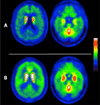Cholinergic dysfunction in Parkinson's disease
- PMID: 23943367
- PMCID: PMC3991467
- DOI: 10.1007/s11910-013-0377-9
Cholinergic dysfunction in Parkinson's disease
Abstract
There is increasing interest in the clinical effects of cholinergic basal forebrain and tegmental pedunculopontine complex (PPN) projection degeneration in Parkinson's disease (PD). Recent evidence supports an expanded role beyond cognitive impairment, including effects on olfaction, mood, REM sleep behavior disorder, and motor functions. Cholinergic denervation is variable in PD without dementia and may contribute to clinical symptom heterogeneity. Early in vivo imaging evidence that impaired cholinergic integrity of the PPN associates with frequent falling in PD is now confirmed by human post-mortem evidence. Brainstem cholinergic lesioning studies in primates confirm the role of the PPN in mobility impairment. Degeneration of basal forebrain cholinergic projections correlates with decreased walking speed. Cumulatively, these findings provide evidence for a new paradigm to explain dopamine-resistant features of mobility impairments in PD. Recognition of the increased clinical role of cholinergic system degeneration may motivate new research to expand indications for cholinergic therapy in PD.
Conflict of interest statement
Martijn L.T.M. Müller, PhD1* & Nicolaas I. Bohnen declare that they have no conflict of interest.
Figures
Similar articles
-
Cholinergic systems, attentional-motor integration, and cognitive control in Parkinson's disease.Prog Brain Res. 2022;269(1):345-371. doi: 10.1016/bs.pbr.2022.01.011. Epub 2022 Feb 4. Prog Brain Res. 2022. PMID: 35248201 Free PMC article. Review.
-
Clinical markers for identifying cholinergic deficits in Parkinson's disease.Mov Disord. 2015 Feb;30(2):269-73. doi: 10.1002/mds.26061. Epub 2014 Nov 12. Mov Disord. 2015. PMID: 25393613 Free PMC article.
-
Molecular Imaging of the Cholinergic System in Parkinson's Disease.Int Rev Neurobiol. 2018;141:211-250. doi: 10.1016/bs.irn.2018.07.027. Epub 2018 Sep 20. Int Rev Neurobiol. 2018. PMID: 30314597 Free PMC article. Review.
-
The involvement of the cholinergic system in Parkinson disease.Handb Clin Neurol. 2025;211:215-229. doi: 10.1016/B978-0-443-19088-9.00001-9. Handb Clin Neurol. 2025. PMID: 40340062 Review.
-
[Rapid-eye-movement sleep disorders in Parkinson's disease].Rev Neurol (Paris). 2002 Feb;158(2):135-52. Rev Neurol (Paris). 2002. PMID: 11965170 Review. French.
Cited by
-
Therapeutic Potential of AAV1-Rheb(S16H) Transduction against Neurodegenerative Diseases.Int J Mol Sci. 2021 Mar 17;22(6):3064. doi: 10.3390/ijms22063064. Int J Mol Sci. 2021. PMID: 33802760 Free PMC article. Review.
-
Moringa oleifera modulates cholinergic and purinergic enzymes activity in BV-2 microglial cells.Metab Brain Dis. 2021 Apr;36(4):627-638. doi: 10.1007/s11011-020-00659-3. Epub 2021 Jan 4. Metab Brain Dis. 2021. PMID: 33394288
-
Frontal lobe metabolic alterations characterizing Parkinson's disease cognitive impairment.Neurol Sci. 2021 Mar;42(3):1053-1064. doi: 10.1007/s10072-020-04626-9. Epub 2020 Jul 29. Neurol Sci. 2021. PMID: 32729012
-
The role of exosomes in the diagnosis of Parkinson's disease.Heliyon. 2023 Oct 16;9(10):e20595. doi: 10.1016/j.heliyon.2023.e20595. eCollection 2023 Oct. Heliyon. 2023. PMID: 37928387 Free PMC article. Review.
-
Short-term deceleration capacity of heart rate: a sensitive marker of cardiac autonomic dysfunction in idiopathic Parkinson's disease.Clin Auton Res. 2021 Dec;31(6):729-736. doi: 10.1007/s10286-021-00815-4. Epub 2021 Jul 12. Clin Auton Res. 2021. PMID: 34251546
References
-
- Langston JW. The Parkinson's complex: parkinsonism is just the tip of the iceberg. Ann Neurol. 2006;59:591–596. - PubMed
-
- Braak H, Del Tredici K, Rub U, et al. Staging of brain pathology related to sporadic Parkinson's disease. Neurobiol Aging. 2003;24:197–211. - PubMed
-
- Bohnen NI, Kaufer DI, Ivanco LS, et al. Cortical cholinergic function is more severely affected in parkinsonian dementia than in Alzheimer disease: an in vivo positron emission tomographic study. Arch Neurol. 2003;60:1745–1748. - PubMed
-
- Mesulam MM, Geula C. Nucleus basalis (Ch4) and cortical cholinergic innervation in the human brain: observations based on the distribution of acetylcholinesterase and choline acetyltransferase. J Comp Neurol. 1988;275:216–240. - PubMed
Publication types
MeSH terms
Substances
Grants and funding
LinkOut - more resources
Full Text Sources
Other Literature Sources
Medical


